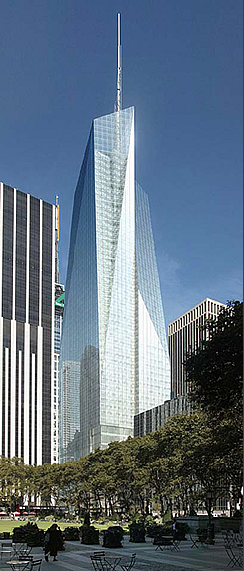One Bryant Park
Setting the standard for the sustainable skyscraper
Challenge:
When the Durst Organization decided to build the tallest green commercial high-rise in the world in mid-town Manhattan, they selected The Fulcrum Group as their commissioning agent. We were engaged at the initial stages of project conception and asked to review and help shape the base concepts for the mechanical and electrical systems.
The original basis of design was for a combined cycle power plant. When the footprint of plant, capital cost, and operating cost projections threatened to end this feature of the building, The Fulcrum Group was asked to evaluate the system and potential alternatives. A Fulcrum Group team specialized in design phase evaluation first reviewed the building’s projected energy consumption profile and made suggestions to its assumptions that better reflected the realities of actual building operation. Once a realistic thermal and electric consumption profile was established it became apparent to the Fulcrum team that a combined cycle plant was overcompensating for electric load while discounting the large financial and sustainable cost of district steam.
The Fulcrum Solution:
At that point, The Fulcrum Group had identified that a combined heat and power plant was a viable alternative to combined cycle that was worthy of comparison. Using standard engineering analysis it was estimated that a combined heat and power plant could save over $35/Mlb of steam generated compared to the original basis of design drawing from district steam.
Based on the Fulcrum team’s construction experience, it was identified at the basis of design phase that a combined heat and power plant could fit into a smaller footprint than a combined cycle plant; an invaluable benefit in the Manhattan commercial building market. Because a combined heat and power plant reclaims steam condensate as feedwater for the heat recovery steam generator instead of draining to the sewer system with quench water, it was estimated that over 20 million gallons of water could be saved annually.
The Fulcrum Group quantified and presented each of these benefits early in the design phase and the decision was made to shift the basis of design to combined heat and power.We continued to interface with the design team to shape the sizing and layout of equipment to maximize the benefits and ensure the necessary detail was included in the project bid package. Our engineers also provided input, assumptions, and quality control for the DOE 2.1 whole building energy model used for various green building certifications.

